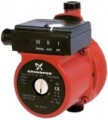The head can be described as the maximum height to which a pump can lift liquid through a vertical pipe without bending or branching. This parameter is directly related to the pressure that the pump produces: 10 m of head approximately corresponds to a pressure of 1 bar (do not confuse this parameter with operating pressure — see more about it below).
The head is one of the key specs for most circulation pumps. Traditionally, it is calculated based on the difference in height between the location of the pump and the highest point of the system; however, this principle is relevant only for units that
boost the pressure of cold water(see "Suitable for"). Circulation pumps for heating and DHW work with closed circuits, and the optimal pressure depends on the total hydraulic resistance of the system. Detailed calculation formulas for the first and second cases can be found in special sources.
It is the material from which the outer part of the pump housing is made.
—
Stainless steel. As the name suggests, stainless steel is virtually corrosion-resistant. However, this is not its only advantage — this material is very durable and reliable, due to which it is used even in powerful high-performance models.
—
Cast iron. This material is in many ways similar to steel — in particular, it is considered very reliable — but it has a slightly higher weight. On the other hand, in most cases, this is not a noticeable drawback, but cast iron costs a little cheaper than stainless steel.
—
Brass. An alloy based on copper and zinc, which has a golden colour. The varieties used in circulation pumps are highly resistant to corrosion and even surpass stainless steel. Therefore, this option is well suited for water with a high oxygen content. The disadvantage of brass can be called a higher cost than that of the same steel.
—
Bronze. Another copper-based alloy. According to the main features, this material is similar to the brass described above.
— Plastic. Units with plastic housings are lightweight, inert to water, and completely unaffected by corrosion. Moreover, polymer materials allow almost any thickness of the body, which determines the requirements of the mould for casting the workpiece. The di
...sadvantage of plastic is its low mechanical strength. The plastic housing can be damaged on the outside and outside due to any kind of impact.
